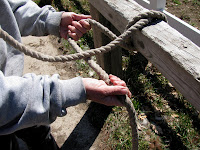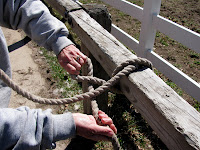One of the first things taught to me after I bought my first horse, and one of the first things I teach kids, is how to safely tie a horse to the hitching rail. The man I bought my first horse from knew that I was a raw beginner, but I can still remember the look of horror on his face when he delivered my horse and saw me tie him up with a solid knot. That was my first important safety lesson. There are probably many ways to safely tie a horse with a knot that is easily undone, but this is the one I learned and has stood me in good stead over the years.
 Tying a Horse to the Hitching Rail
Tying a Horse to the Hitching RailWhen you bring your horse to the hitching rail, place the lead rope over the top of the rail, bring it under the rail, cross it over the rope and then back under the rail.

 Take the tail end in both hands with it underneath the part of the rope attached to the halter and hold it so that it looks like a “4.”
Take the tail end in both hands with it underneath the part of the rope attached to the halter and hold it so that it looks like a “4.” Twist your hand holding the section of rope coming from the hitching rail, making a "hole."
Twist your hand holding the section of rope coming from the hitching rail, making a "hole." Then with the opposite hand, put the looped rope end through that hole.
Then with the opposite hand, put the looped rope end through that hole. Holding the rope that is attached to the halter, push the knot towards the hitching rail until it tightens.
Holding the rope that is attached to the halter, push the knot towards the hitching rail until it tightens.This knot is a slip-knot; it is easily undone by pulling on the dangling end of the lead rope. The reason why I cross the rope over itself on the hitching rail is that in case the horse pulls back, that cross-over keeps the knot from pulling so tight that it can’t be undone – I found that out through experience!
 I also learned through experience to place the end of the lead rope back through the loop because if the horse starts playing around and grabs the end of the lead rope in his teeth and pulls, he can untie himself.
I also learned through experience to place the end of the lead rope back through the loop because if the horse starts playing around and grabs the end of the lead rope in his teeth and pulls, he can untie himself.Another thing to keep in mind is the types of lead ropes you use can affect how "slippery" the knot is. Cotton ropes tend to hold more snugly, while nylon lead ropes - naturally a more slippery material - will still remain knotted but the knot can loosen on the hitching rail, making it very easy for your horse to move away from where he was originally tied!
Reprinted from Equine Tips | Horse Training & Care!
